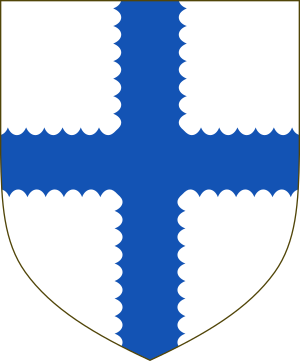William Sinclair, 5th Lord Sinclair facts for kids
Quick facts for kids
Henry Sinclair
|
|
|---|---|
| Lord Sinclair | |

Lord Sinclair coat of arms
|
|
| Predecessor | Henry Sinclair, 4th Lord Sinclair |
| Successor | Henry Sinclair, 6th Lord Sinclair |
| Died | 1570 |
| Noble family | Clan Sinclair |
| Father | Henry Sinclair, 4th Lord Sinclair |
| Mother | Margaret Hepburn |
William Sinclair (died 1570) was an important Scottish nobleman. He held the title of the 5th Lord Sinclair. Historians like Roland Saint-Clair and Bernard Burke agree that he was truly the fifth person to hold this title.
Contents
Early Life and Family
William Sinclair was the son of Henry Sinclair, 4th Lord Sinclair and Margaret Hepburn. His mother, Lady Margaret, was the daughter of Adam Hepburn, Master of Hailes. She was also the sister of Patrick Hepburn, 1st Earl of Bothwell.
After William's father passed away in 1513, his mother, Lady Margaret, managed the King's lands in Orkney for almost 30 years. William's father had worked to regain control of these islands. He had even leased the earldom of Orkney for 19 years. In 1514, it was noted that William's father had sold eight cannons to James IV of Scotland. The money from this sale was paid to his mother after his death.
The Orkney Rebellion
Trouble in Orkney
A few years after William's father died, the people of Orkney chose their own leader. This leader was James Sinclair, who was very wealthy and from Orkney. The Orcadians stopped paying their rents to William's mother for three years. They also forced William Sinclair, the 5th Lord, to give up Kirkwall Castle. William had to escape to Caithness.
Lord Sinclair's Fight for Control
In 1528, William Sinclair joined the Council of Nobles. This group was put together by James V of Scotland. The King then gave Lord Sinclair a special document. This document allowed him to invade Orkney. The goal was to make James Sinclair give up his power.
Lord Sinclair teamed up with John Sinclair, 3rd Earl of Caithness, who was a close relative. They gathered a large army and attacked Orkney. However, they were defeated in the Battle of Summerdale. The Earl of Caithness and 500 of his men were killed. Lord Sinclair was captured during the battle.
Before the battle, James Sinclair had already killed some of Lord Sinclair's friends. After the battle, he killed 30 more men who sought safety in St Magnus Cathedral. King James V showed his power by giving Lady Margaret Sinclair her rights to the islands back until 1540. Even though James Sinclair had defeated the invasion, King James later made him a knight.
Royal Connections
In 1543, the Queen Dowager started a legal case against Oliver Sinclair. William Sinclair, the 5th Lord, made it clear that he should not be linked to Oliver Sinclair's actions.
In 1544, William Sinclair agreed to support Mary of Guise, who was the Queen-Mother. She was acting as regent (a ruler for a young king or queen) of Scotland. He supported her against the Earl of Arran.
Lands and Important Papers
William Sinclair received many important documents called charters. These papers gave him ownership of lands.
- On April 17, 1524, he received a charter for the lands of Newburgh, Aberdeenshire. This also included the fishing rights in the River Ythan. His wife, Elizabeth Keith, was also named in this charter.
- In 1543, he officially took possession of the baronies of Dysart, Fife and Ravenscraig.
- On June 28, 1547, he and his wife received more charters. These were for the lands of Wilstoun, Carberry, and Balbeggy in Fife.
In 1542, he received a special pardon from the Privy Seal of Scotland. This pardon was for helping in a rebellion led by George Home, 4th Lord Home.
Family Life
William Sinclair, 5th Lord Sinclair, married Lady Elizabeth Keith. She was the widow of Colin, Master of Oliphant. She was also the daughter of William, the 3rd Earl Marischal. They had the following children:
- Henry Sinclair, 6th Lord Sinclair, who became his heir and took over his title.
- Magnus Sinclair, of Kinninmonth.
- Margaret Sinclair.
See also

